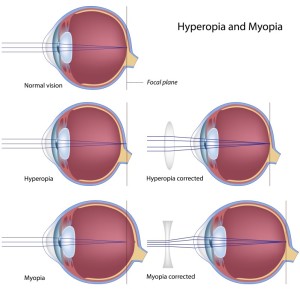Posted by: Georgia Eye Physicians and Surgeons in Latest News
At Georgia Eye Physicians and Surgeons, our comprehensive consultative optometrist Dr. Marc Lay helps hundreds of men, women, and children achieve better vision by prescribing glasses or contact lenses. However, despite the fact that more than 150 million Americans use corrective eyewear to compensate for refractive errors in vision, many people do not understand exactly how vision correction works. Here is some insight into the most common causes of visual impairment, the basic refractive errors that cause nearsightedness, farsightedness, and astigmatism.

For Nearsightedness
In cases of myopia, or nearsightedness, there is difficulty focusing on images that are far away, although close range vision generally remains clear. This is because the eye is disproportionately large, so the rays of light intersect too soon and then spread out again, making them out of focus by the time they actually do reach the retina. A concave lens (one that is narrower in the center and wider at the edges) placed in front of the eye spreads the rays of light out slightly before they reach the lens. This means that when the rays of light do meet at the focal point, that point is further back in the eye, allowing the light to focus clearly on the retina.
For Farsightedness
When the eye is too small, rather than too large, the result is hyperopia, or farsightedness. The eye generally is able to focus clearly on objects that are far away, but has difficulty when viewing at close range, although with more severe cases of hyperopia, vision at all ranges suffers. Because the eyes are smaller than is typical, the light does not have sufficient space to focus fully before it reaches the retina. A convex lens (one that is wider in the center and narrow at the edges) causes the light to start converging earlier, allowing the focal point to fall on correctly on the retina.
For Astigmatism
Astigmatism, which can often occur in eyes that are also nearsighted or farsighted, is somewhat more complicated but still an extremely common condition. Rather than (or in addition to) the eye being too large or too small, it is also irregularly shaped, with a slightly different curvature in one direction than in another. Instead of looking like a perfectly spherical basketball, an eye with astigmatism has a shape more like that of a football. Because the light entering the eye does not pass through a smooth lens, it does not focus on a single point and patients experience blurring and distorted images at any distance. Using precise measurements of the eye, Dr. Lay can replicate the exact degree of distortion needed to refocus the light entering through the lens so that it can focus clearly.
In addition to using lenses to adjust the focus on the light as it enters the cornea, refractive errors like these can also be corrected permanently by using laser eye surgery procedures, like PRK or LASIK, to change the shape of the eye itself. These procedures, which board-certified ophthalmologist Dr. William Segal can usually perform in as little as 15 to 30 minutes, are not suitable for all candidates, but have an extremely high satisfaction rate among patients suffering from nearsightedness, farsightedness, and even astigmatism. If you would like to schedule an eye examination to determine if you need glasses or contacts, or if you are interested in LASIK surgery for clearer vision, please contact Georgia Eye Physicians and Surgeons. Be sure to follow us on Facebook, Twitter, and Google+ for more information on how to keep your vision clear.

